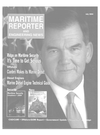
Page 10: of Maritime Reporter Magazine (July 2004)
Gulf of Mexico: Floating Production Systems & Support Vessels
Read this page in Pdf, Flash or Html5 edition of July 2004 Maritime Reporter Magazine
Government Update aquatic non-indigenous species, ballast water manage- ment programs have been introduced. One of the first was mandated for ships entering the Great Lakes from outside North America. These ships are required to demonstrate that they have exchanged their ballast water on the high seas while en route. High seas bal- last water exchange remains the most widely accepted and widely utilized of the control techniques. This is true despite its downsides. Disposal of ballast water on the high seas may expose the ship to stability risks, par- ticularly in heavy weather. Even the best current bal- last water pumping systems do not fully empty the bal- last tanks, leaving some water and sediment (along with the potential for non-indigenous critters) in the tanks when they are refilled. Some ships transit exclu- sively in coastal or shallow-water areas where ballast water exchange may provide minimal value. Australia has introduced a ballast water management program that includes a risk analysis to determine the likelihood that a ship's ballast water might contain harmful non- indigenous species.
To reduce the probability that ballast water would contain significant numbers of non-indigenous species, the International Maritime Organization (IMO) estab- lished a set of voluntary guidelines. These include cau- tions against uptake of ballast water in very shallow water or in darkness when bottom-dwelling organisms may rise up the water column. These guidelines were adopted by the U.S. Coast Guard (and have been made mandatory by the State of California).
The United States initially adopted a voluntary approach to ballast water management (except in Great
Lakes and in the Hudson River north of the George
Washington Bridge).
The original program included a requirement that ships arriving from overseas report what ballast water management techniques were utilized on the voyage, but the techniques were only recommended and there was no penalty for not utilizing them and there was no penalty for failure to make the report. After three years, the results were not good. Only about 30 per- cent of arriving ships submitted the reports and only about 50 percent of the reporting ships stated that they had exchanged their ballast water or utilized other techniques.
The Coast Guard asserts that a major reason for the new mandatory reporting requirement is to "generate more data that will allow for a more thorough under- standing of ballast water delivery and management practices and how these relate to invasions of non- indigenous species (NIS) from vessel's ballast water on both a national and regional basis."
A stronger basis for the regulation is that Congress mandated such an effort. The voluntary program was. from the beginning, a three-year program to see if the marine industry would substantially participate on its own. When it did not, the Coast Guard had no alterna- tive to making the program mandatory.
The Coast Guard is also engaged in an effort to encourage development of experimental techniques for ballast water treatment that could eventually be used instead of high seas ballast water exchange. The agency established a program through which ship own- ers can apply for acceptance of experimental treatment systems.
Once accepted, the installation could be utilized for the life of the ship. This effort promises long-term, albeit long delayed, benefits for masters and crew, who will no longer face the uncertainties and dangers of high seas ballast water exchange.
A second effort involves establishing water quality standards for ballast water discharged into U.S. waters.
The Coast Guard is attempting to develop a ballast water treatment goal and an interim ballast water treat- ment standard. This standard could then be used to judge the efficacy of new ballast water treatment tech- niques.
In addition to the reporting requirement, the Coast
Guard has prepared a rulemaking to expand the manda- tory ballast water management program from the Great
Lakes and Hudson River to all U.S. waters. The draft rule was submitted for review to the Office of
Management and Budget (OMB) on April 7, 2004. Its approval and subsequent official promulgation are
MARITIME & INDUSTRIAL
WASTE OIL CLEAN- UP
Through Bioremediation
Sarva Bio Remed, LLC, Trenton, NJ USA
Phone: 877-71-SARVA; Weh: www.sarvabioremed.com
Circle 258 on Reader Service Card
TRACTOR PINS
FOR TODAY'S TUGS
WESTERN MACHINE WORKS 1870 Harbour Road - North Vancouver, B, C - Canada - V7H 1A1
Phone: (604) 929 -7901 Fax (604) 929-7951 or (604) 929-5329
Circle 255 on Reader Service Card 8MJ-622-5364 * mw.gppiub.com1 Log On For Your Dealer
Circle 235 on Reader Service Card
RELOCATION
CT MARINE
NAVAL ARCHITECTS • MARINE ENGINEERS
Is changing the location of operations effective
July 19. 2004
To: 86 Fort Road
Edgecomb, Maine 04556
Phone: 207-882-4474 • Fax: 207-882-4475
Website: www.ctmarine.com
Email: [email protected]
Our commitment to serve the Marine Field specializing in
Ocean Barges. ATB's. Propulsion and will not change!
MAR INI' I XIIAUS'I SYSTI-MS
OF ALABAMA INC.
P.O.Box 698 757 Nichols Ave
Fairhope, AL 36533 1-251-928-1234
Phone/Fax
Mesamarinefa Earthlink.net http://ww w.niesaniarine.com
Water Cooled Manifolds. Heat Exchangers, Collector
Risers, Mufflers, and Custom Fabrication for Caterpillar,
Cummins, Onan, Detroit. Perkins, Waukesha.
Westerbeke, Hercules, Mack. Isuzu, John Deere, Kubota,
Daewoo, Isotla Fraschini. Ford, Palmer, International,
Fairbanks Morse. Lister. Wisconsin, and more.
Marinization, Repair, and Duplication of Obsolete Paris available upon request.
Please Contact us for all of your exhaust needs.
SUNDIAL
MARINE CONSTRUCTION & REPAIR
COLUMBIA RIVER'S LARGEST
FULL SERVICE SHIPYARD
New Construction, Repairs, Drydocking "Quality workmanship at a fair price"
PORTLAND, OREGON tel (503) 667-1974 fax (503) 666-7872
Email: [email protected] www.sundial-marine.com
Circle 214 on Reader Service Card Circle 237 on Reader Service Card Circle 275 on Reader Service Card 10
GLOBAL POWER PRODUCTS
A Division Of Mack Boring & Parts Company 2,3 S4 Inch
Portable Pumps.
Yanmar Powered.
To Start. CAM Certified.
Trash, Centrifugal, Diaphragm, Pressure.

 9
9

 11
11
